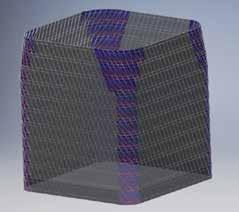
9 minute read
A Story of Innovation in Alberta
By Mark Botkin

Left: The MacKimmie Complex at the U of C is a double-skin, net zero energy project that features a very complex panel mounting framework. Above: A test model built over three days with the AutoCladding Method using Graham Architectural panel technology, just to demonstrate the possibilities.
Walson Tai of the Calgary Climbing Centre (CCC) had heard I was researching the application of software methods to the manufacture of building envelope components and wanted to know if my work could be adapted to his problem. He was building his business around the technology of climbing walls and had an idea that would push his company to the forefront of this growing industry. Artificial climbing walls use complexity as their chief selling point to clients, attempting to mimic the real world climbing experience. The problem is that manufacturing these structures with a lot of complexity is expensive and the outcomes to this point in time were somewhat disappointing. Unfortunately, what he wanted to do was for practical purposes impossible with existing methods.
The design Walson wanted to implement was grounded in the idea of using large numbers of panels that would intersect each other at varying angles to form arbitrarily complex surfaces. Strength would come in part with the tightly mitered intersection of each edge with its neighbour. Strength is an important property as people would be hanging from them. This was an ambitious and creative upgrade to the then available climbing wall technology. The parallels embodied in this design method with panel-based building envelope components were not lost on me, so I agreed to look into it. If nothing else, the climbing wall project was potentially a convincing proof of concept that could validate the assumptions I was making about the use of software in dealing with the construction of complex cladding in a cost-effective manner. The software in question, which I dubbed ‘AutoCladding’, was designed to run on top of Autodesk® Inventor®. The choice of Inventor was driven in no small part by the effort I had put into learning this application and by a desire to not reinvent the wheel with features like project management, sketching, and part and assembly management. From the start it was clear that the user interface had to be simple enough to accommodate someone who was more artist than engineer, and Walson proposed using another Autodesk product, 3ds Max® to create sketch dwg files that would form the primary geometry specification for each wall. It was evident to me that this would be a large, complex project and would require close collaboration, but it was also intrinsically interesting and had the potential to advance the fortunes of more general panel manufacturing. On the input side, the AutoCladding application had to be able to import and interpret a dwg formatted sketch file for each wall, parsing out panel profiles and creating data structures to represent them. This would be expanded to accommodate any application that could produce a sketch dwg file, including Inventor. Also important was the digital prototype assembly the AutoCladding application created from this data. Each wall model had to represent many, possibly
thousands, of panels, each one unique in its form, dimensions, edge mitering and mounting details. This meant that the model had to record specific information on every single panel that could be referenced at any time in the modeling process. The AutoCladding application, as it then existed, already had the ability to create dxf formatted production files suitable for driving CNC tools, and this proved to be important, as the CCC intended to produce the panels and components inhouse, without the use of drawings.
The first major installation created this way was the so-called Hanger site near the Calgary airport.
This project revealed a few issues, not surprising for software of this level of complexity, but the project was deemed a success. The problems encountered were addressed and another even more ambitious project was undertaken, the so-called Rocky Mountain site in Calgary’s Canada Olympic Park.
This 35,000-square-foot facility is unique. The interior is a stunning array of climbing surfaces of previously unimagined complexity. It also features one of the largest and most detailed outdoor artificial climbing surfaces in the world. The CCC website has a must-see video tour. So far, the reaction locally to this series of projects has been undetectable outside the climbing community. I submitted this work to CanBIM for their 2020 Innovation Spotlight Awards and was nominated in the Digital Products category. This work has received a lot of attention because of this, especially in Eastern Canada, but it seems as if the implications of the AutoCladding technology for the wider envelope manufacturing industry are still being missed. In summary, this is a story of the tension between vision and risk, and the way two unrelated threads in the technology world can combine and make something that was previously impossible not only possible, but cost-effective. This project has lessons for the wider envelope manufacturing industry, if they decide to take notice.
The next step
I continued the development and extension of the AutoCladding method with the help of data provided by Aluminum Curtainwall Systems of Kamloops and the online frame profile catalog of Graham Architectural. I decided to focus on unitized curtain wall implementations where the infill can be a range of materials including glazing. In its current form, the AutoCladding application can be used to read and interpret shop drawings showing frame profile details, from which it separates individual profiles into libraries. Detailing such as mounting holes and slots can also be captured in this way. Structural geometry is supplied via 2D and 3D sketching and panels generated using a set of design rules specified for each panel technology and workflow. The AutoCladding application will automatically populate panel frames. From the master assembly created in this fashion production data in the form of dxf formatted files for CNC tools can be generated. In addition, fully formatted production drawings can be created at the rate of about one per second. Other types of documentation can also be sourced from the model.
Conclusions
Automation built around the digital prototype has proven its worth in the climbing wall project. Models constructed using these automated processes tend to have a smaller
With over 15 Years’ Experience in Supply and Install of: • Vinyl Siding • Hardie Board Cement Siding • CanExel Siding • Lux Metal Cladding • Sagiper Siding • Soffit & Fascia
www.absoundexteriors.com No job is too small!

6235 Wagner Road NW, Edmonton, AB T6E 4N4 780-430-9353 reception@absoundexteriors.com
memory footprint, in part because they do not depend on the knowledge and ability of individual modellers, but also because there is reduced need for many of the construction features that are required to model via the user interface. This means larger models can be accommodated. In addition, the master assembly created by the AutoCladding method is rarely edited directly, so the performance of the user interface is less of an issue. This is important because many commercial projects can be dauntingly large. In the 3D printing world this process is called generative design.
The advancement of envelope manufacturing automation may be further enhanced with Artificial Intelligence. I have initiated communication with the Alberta Machine Intelligence Institute with a view to exploring these techniques applied to a wide array of design and implementation challenges related to the problems facing the envelope manufacturing sector.
The future could eventually see these methods adopted by architects to evaluate technology choices and perform cost projections. Point cloud data collected by laser scanning could be evaluated with the AutoCladding method to facilitate panel remediation projects. Roofing and below grade structures are also candidates for automation.
Current development is focused on automating the generation of manufacturing data for house designs where most of the work is focused on sketching the desired geometry. The CMHC has recently announced a $300-million initiative to address the affordable housing crisis, and the AutoCladding app is poised to play a significant role in addressing both cost and sustainability issues.
What does all this mean?
There are two important points arising from this experiment.
1. The construction industry is being compelled to accept the fact that software is the technology that will advance their fortunes for the foreseeable future. The construction industry must acknowledge the disconnect between what they pay for software and the actual value it creates in efficiency and reduced ECOs. They need to understand that software development in the area of manufacturing is extremely difficult and expensive, and while there are all too frequent foul ups, when software is done right, the results can be spectacular.
2. The software industry has to face up to the fact that there is a crippling lack of trust caused by aggressive marketing on the part of resellers that seek to meet quotas, rather than address the real problems manufacturers have.
Software vendors have to start taking up common cause with manufacturers, and in particular, they must assume some of the risk manufacturers take when they adopt new methods and tools based on software. The construction industry is built on a culture of what amounts to gambling. Fundamental processes like bidding on contracts even use gambling terminology and the outcome of a given project is never completely known until the final tally. This means that any kind of change comes with risk, and the software industry has to acknowledge their role in this. The close collaboration between Alberta Data Systems and the Calgary Climbing Centre represent one model for enhancing the flow of technology to create outcomes that would not have been possible otherwise.
The construction industry is at a crossroads as climate change and population pressure push us to improve and innovate to meet the existential challenges arising from the role the shelters we build play in the human story. This is a time to embrace experimental culture and the change it portends. New paneling technology, new materials, new methods and the encroachment of automation on long standing workflows are unavoidable, and we ignore the pioneering work being done outside of the mainstream at our peril. The labour shortage and the lack of a skilled workforce alone are trends that cry out for innovative change. The fringe has a way of becoming the norm in the evolution of technology, and the digital prototyping process driving automation is a direction that deserves critical consideration.
About
I was born on a farm in Saskatchewan and graduated from the University of Saskatchewan with a degree in biochemistry (advanced). I subsequently moved to Edmonton, Alberta, and worked for a cadre of prestigious research groups at the University of Alberta, including the J.S. McEachern Canadian Cancer Society lab, the Mike James X-ray crystallography group and Chembiomed Ltd., an innovative biotechnology company formed in the chemistry department by Dr. Raymond Lemieux, a prominent researcher at the time. From there, my interest in computer systems led to invitations to join a series of technology start-ups, doing everything from computer design to heavy equipment fly-by-wire controls and high-speed telecommunications. The later years have given me the opportunity to develop an expertise in 3D modelling, which when combined with my innate talent for mechanical design, gave me fresh perspectives on the building envelope manufacturing industry and their efforts to solve some of their more pressing productivity issues. I am also an inventor, and have patented a revolutionary bicycle seat design. n








